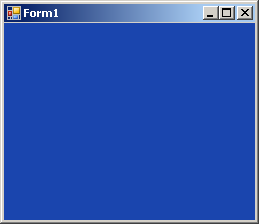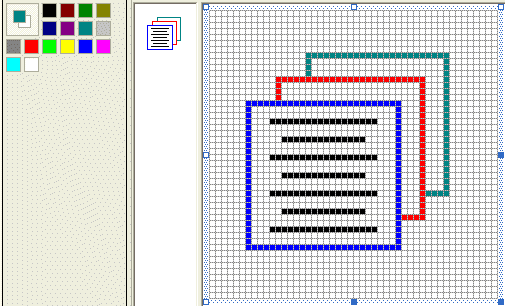|
|
The color is one of the most fundamental objects that
enhances the aesthetic appearance of an object. The color is a non-spatial
object that is added to an object to modify some of its visual aspects. To
support colors, the GDI+ library provides the Color structure. The
Color structure is defined in the System::Drawing namespace.
|
A color is created as a combination of four 8-bit
values. The first value is referred to as alpha but it is mostly used
internally. The second is called red. The third is called green. The
fourth is called blue:
|
|
Bits |
|
Alpha |
|
|
Red |
|
|
Green |
|
|
Blue |
|
Converted to decimal, each one of the red, green, and
blue numbers would produce:
27 + 26 + 25 + 24
+ 23 + 22 + 21 + 20
= 128 + 64 + 32 + 16 + 8 + 4 + 2 + 1
= 255
Therefore, each number can have a value that ranges
from 0 to 255 in the decimal system. The alpha section is reserved for the
operating system. The other three numbers are combined to produce a single
value as follows:
|
Color |
| 23 |
22 |
21 |
20 |
19 |
18 |
17 |
16 |
15 |
14 |
13 |
12 |
11 |
10 |
9 |
8 |
7 |
6 |
5 |
4 |
3 |
2 |
1 |
0 |
| Blue |
Green |
Red |
|
| Value |
Converted to decimal, this number has a value of 255 *
255 * 255 = 16581375. This means that we can have approximately 16 million
colors available. The question that comes to mind is how we use these
colors, to produce what effect.
You computer monitor has a surface
that resembles a series of tinny horizontal and vertical lines. The
intersection of a horizontal line and a vertical line is called a pixel.
This pixel holds, carries, or displays one color:

As the pixels close to each other have different
colors, the effect is a wonderful distortion that creates an aesthetic
picture. It is by changing the colors of pixels that you produce the
effect of color variances seen on pictures and other graphics.
To make color selection easier,
the Color structure is equipped with various properties that each
represents a name for a color. Therefore, to use any of these colors, call
the Color structure followed by the "::" operator, followed by the
desired color. All the popular names of colors are recognized and they are
represented in the Color structure by static properties. These
include Red, Green, Blue, Black, White,
Yellow, Fuchsia, Silver, Gray, Brown,
and Khaki, etc, just to name a few. There are many other colors
that are not necessarily popular. Here is an example:
System::Void Form1_Load(System::Object^ sender,
System::EventArgs^ e)
{
BackColor = Color::Turquoise;
}
If none of the pre-defined colors suits you, you can
define your own color as a combination of red, green, and blue values. To
create a color using this approach, you can declare a variable of type
Color. To specify the characters of the color, the Color
structure provides the FromArgb() static method overloaded in four
versions as follows:
public:
static Color FromArgb(int argb);
static Color FromArgb(int alpha, Color baseColor);
static Color FromArgb(int red, int green, int blue);
static Color FromArgb(int alpha, int red, int green, int blue);
The third version, which is the most used allows you
to specify three values that each ranges from 0 to 255. Here is an
example:
System::Void Form1_Load(System::Object^ sender,
System::EventArgs^ e)
{
BackColor = Color::FromArgb(26, 69, 174);
}
This would produce:

Whether a color was initialized with
one of the Color pre-defined color properties or using the
FromArgb() methods, if you want to retrieve the red, green, and blue
values of a color, you can use the R, the G, or the B
properties to extract the value of each. Each one of these properties is
of a byte type. Alternatively, you can call the Color::ToArgb()
method. Its syntax is:
public:
int ToArgb();
This method returns an integer.
|
Setting the Color of, or Painting, a Pixel
|
|
In our introduction to GDI+, we saw that the screen of
a computer monitor uses a series of horizontal and vertical lines, the
intersection of two perpendicular lines is a pixel. Each pixel holds one
color. Of course, two adjacent pixels can hold the same color or each can
hold a different color.
A bitmap is a series of colored adjacent pixels. Put
another way, for a group of pixels to be considered a bitmap, these pixels
must constitute a group. A bitmap is made by specifying the color of each
pixel. This means that the pictures we have used so far were simply made
of pixels and each pixel held an appropriate color.
If you decide to create or design a picture using the
tool resources in Microsoft Visual C++ available from the Resource View
(or the Solution Explorer), you would experiment, on a large scale the
ability to specify the color of each individual pixel, using (a limited
list of) colors:

Actually, when you have a bitmap, you can access any
pixel of the picture and then you can either specify its color or get its
current color.
To allow you to specify the color of a pixel, the
Bitmap class provides a method named SetPixel and its syntax
is:
public:
void SetPixel(int x, int y, Color color);
The x and y arguments represent the left
and top values of the location of the pixel. The 3rd argument specifies
the new color that the pixel will hold. Here is an example:
System::Void Form1_Paint(System::Object^ sender,
System::Windows::Forms::PaintEventArgs^ e)
{
Bitmap ^ bgDrawingArea = gcnew Bitmap(Width, Height);
e->Graphics->DrawImage(bg, 0, 0);
for(int i = 0; i < Width; i += 20)
for(int j = 0; j < Height; j += 20)
{
bgDrawingArea->SetPixel(i, j, Color::White);
Graphics ^ painter = Graphics::FromHwnd(Handle);
painter->DrawImage(bgDrawingArea, 0, 0);
}
}

To know the color of a pixel on a picture, you can
call the Bitmap::GetPixel() method whose syntax is:
public:
Color GetPixel(int x, int y);
The x and y arguments represent the left
and top values of the location of the pixel whose color you want to get.
This method returns the color of that pixel.
|
Getting the Color of a Pixel
|
|
We previously mentioned that a picture was a series of
pixels with each pixel holding a color. As opposed to specifying the color
of a pixel, you can retrieve its color. To support this, the Bitmap class
is equipped with a method named GetPixel. Its syntax is:
public:
Color GetPixel(int x, int y);
As you can see, this method takes two arguments that
represent the Cartesian coordinates of the pixel. The method returns a
Color value.